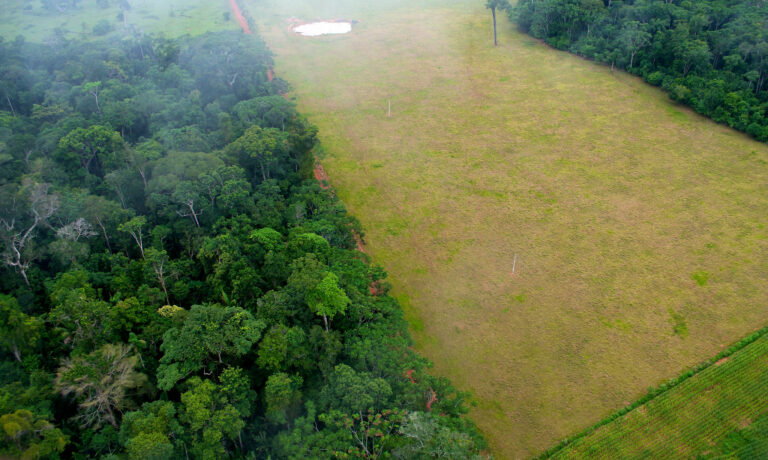On May 31, the State Department announced the release of a report on combatting deforestation associated with production of agricultural commodities. Unfortunately, instead of mapping out a plan for concrete action, the report effectively called for more study of the issue.
Other wealthy countries are taking a more serious path to tackling one of the key drivers of the climate change crisis. On May 23, the European Union approved its new Deforestation Regulation in an effort to use the bloc’s economic leverage to decrease the incentives to cut down trees, particularly in rainforests in places like Brazil and Indonesia.
Forests are vital for the health of our planet, including as carbon sinks. But deforestation also has a direct impact on the lives and rights of millions of people. The International Union for the Conservation of Nature (IUCN) estimates that nearly 25% of the global population relies on forests for their livelihoods, including many of the world’s poorest communities. Forests provide surrounding communities with clean drinking water, food, and jobs. When forests are cut down, the impact on local communities can be devastating. The world’s Indigenous populations suffer some of the worst impacts of forest destruction, with deforestation sometimes displacing entire Indigenous communities.
Yet deforestation is rampant, driven in large part by agricultural production, including cattle ranching and palm oil. The UN’s Food and Agriculture Organization estimates that more than 1.6 million square miles of forest have been lost worldwide since 2010 – an area the size of Argentina.
The EU’s new Deforestation Regulation requires importers and exporters of seven agricultural commodities (and products derived from them) to ensure that they have not been produced or harvested from recently deforested areas both within the EU and in the rest of the world. This follows the EU’s recent Corporate Sustainability Reporting Directive which requires both EU companies and non-EU companies doing significant business in the EU, or with securities listed on an EU exchange, to report on how their business plans are compatible with the goal of limiting global warming to 1.5° C. It also requires them to report on how they comply with human rights norms in their own operations and the companies in their supply chains.
The Deforestation Regulation covers cattle, cocoa, coffee, oil palm, rubber, soy, and wood, as well as specified products derived from those commodities, including chocolate, coffee, paper, and leather. Businesses placing those goods in the EU market or exporting them from the EU must conduct due diligence to ensure that they were not produced on land deforested after December 31, 2020. Compliance with the due diligence obligation requires geolocation of the specific farms where the commodities were produced.
Companies must also ensure that the commodities were produced in compliance with “relevant law,” which is defined to include labour laws, human rights protected in international law, and the principle of free, prior, and informed consent of the local community. Penalties are significant – up to 4% of annual turnover in the relevant EU country. Customs and other governmental authorities will be empowered to block the import or export of commodities and products that are not “deforestation free” or whose production has not been legally compliant.
The EU regulation is not perfect. It should be expanded to cover additional forest-risk commodities and key ecosystems like savannahs and wetlands that are also hugely important carbon sinks. The regulation should cover suppliers as well as commodities so that suppliers and businesses can’t merely segment their production and sell the “clean” products to Europe, while selling “dirty” products linked to deforestation elsewhere. Ultimately, the regulation’s success will depend in large measure on how the EU and member states enforce it, whether other countries adopt similar measures, and how the producers of commodities linked to deforestation respond to enforcement efforts. But it represents an important step toward ensuring that the huge EU market does not continue to contribute to large-scale deforestation and accompanying human harms.
Unfortunately, the U.S. is moving far too slowly. The proposed FOREST Act of 2021 has been languishing in Congress for nearly two years. The bill would prohibit the importation of six listed commodities – palm oil, soybeans, cocoa, cattle, rubber, and wood pulp – and specified products made from those commodities, if they were grown on land illegally deforested after the date the law comes into effect. The law would also require the US to develop “action plans” with regard to countries viewed as at risk of deforestation, and would appropriate money to help them combat deforestation. In addition, the bill would amend U.S. laws against money laundering to make it illegal to conduct financial transactions involving proceeds from illegal deforestation abroad.
President Biden should make passage of a strong law on deforestation a major priority. He should call on Congress to pass a strengthened FOREST Act that matches or surpasses the EU regulation. The FOREST Act exempts deforested land on its own national territory, only covers commodities grown on land that was illegally deforested instead of all deforested land, and only covers land deforested after the law goes into effect. In glaring contrast to the EU regulation, it doesn’t impose any requirements to comply with international human rights standards.
The combined influence of the EU’s Deforestation Regulation and the FOREST Act would meaningfully shrink the global market for commodities produced on deforested land. This would in turn powerfully reduce incentives to continue cutting down forests. If implemented properly, they would make a major difference in reducing climate change and protecting basic rights. It is time for the U.S. to act.
Photo Credit: An aerial shows the contrast between forest and agricultural landscapes near Rio Branco, Acre, Brazil. Photo by Kate Evans/CIFOR (CC BY-NC-ND 2.0).







